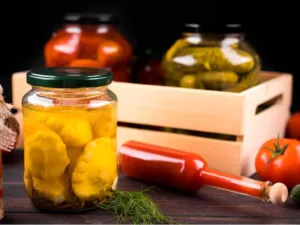Imagine turning simple vegetables in your kitchen into tangy, probiotic rich delights. Bacterial fermentation is an old age technique and has grown its popularity among health-conscious foodies. Whether you are an experienced home fermentor or a curious newbie, we will guide you through the essential tips and tricks for successful fermentation. With attention to practical advice and easy to follow steps, you will soon enjoy homemade fermented foods that boost your gut health and enchant your taste buds.
Benefits of Bacterial Fermentation
Bacterial fermentation transforms everyday ingredients into exceptional health boosters. Firstly, by harnessing the power of bacteria, you can create delicious and nutritious foods in your kitchen. Moreover, fermented foods like sauerkraut, kimchi, and yogurt are packed with probiotics that support the gut microbiota. Additionally, these beneficial bacteria play an important role in maintaining a healthy gut microbiome, which, in turn, supports overall wellbeing. Consequently, incorporating fermented foods into your diet can significantly enhance your health.
Choose the Right Ingredients
For successful fermentation, start with high quality ingredients. Here is what to consider:
- Vegetables and Fruits: Choose organic options to avoid pesticides and contaminants.
- Dairy: Use whole milk without additives for the best results.
- Water: Choose filtered water to avoid chlorine and other chemicals.
Essential Equipments for Home Fermentation
You do not need fancy equipment to ferment foods at home. In fact, basic equipment such as glass jars, fermentation weights, and airlocks will suffice. First and foremost, make sure your jars are clean and free of any soap residue, as these can interfere with the fermentation process. Additionally, a good set of measuring spoons and kitchen scales will help maintain consistency in your dishes.
Role of Salt in Fermentation
Salt plays a crucial role in bacterial fermentation. Specifically, it creates an environment where beneficial bacteria thrive while simultaneously inhibiting harmful bacteria. Furthermore, the exact amount of salt can vary depending on the recipe. However, a general rule is to use 2-3% of the vegetable’s weight in salt. Additionally, sea salt or pickling salt is preferable over table salt, which contains iodine and can affect the taste and texture of your fermentation.
Temperature and Time
Fermentation is a time sensitive process influenced by temperature. Most vegetables are best fermented at room temperature, around 65-75 °F (18-24 °C). Too hot, and increases fermentation speed, possibly leading to spoilage. Too cold, and the process slows down or stops. Check your fermentation daily and taste them to monitor their progress. A tart, sour taste indicates that they are ready.
A Spicy Fermentation Adventure
Want to level up? Then try your hand at kimchi. This Korean staple not only combines Napa cabbage with a delicious paste of gochutgaru (Korean red pepper flakes), garlic, ginger, and fish sauce, but also offers a fantastic fermentation process. Consequently, these bold flavors meld into a complex, spicy sour spice. Furthermore, you can experiment with adding carrots, radishes, or even fruit for unique variations.
Resolution of common problems
Even experienced fermentors face issues. For example, if your fermentation develops mold, it’s usually safe to remove the top layer. However, if mold penetrates deeper, you should discard it. Additionally, the slimy texture often results from very low salt concentrations or extremely hot temperatures. Therefore, adjusting these factors can prevent future problems. On the other hand, a foul odor indicates contamination, and in that case, the batch should be thrown away.
Experimenting with Flavors

Fermentation is not just about health benefits; moreover, it’s a culinary adventure. For example, you can experiment with different vegetables, spices, and herbs to create unique flavor profiles. Additionally, you might add garlic, ginger, or chili peppers to your sauerkraut for a spicy kick.
Similarly, try incorporating oregano seeds in your fermented carrots for a hint of sweetness. Consequently, the possibilities are endless, and the results can be both surprising and delightful. Furthermore, each new combination offers a chance to discover exciting tastes and textures.
Supporting Gut Health
Adding fermented foods to your diet offers several benefits for your gut:
- Digestive Health: Probiotics help maintain a healthy gut microbiome.
- Immune Support: A balanced gut microbiota can boost your immune system.
- Mental Well-Being: Some studies link gut health to improved mood and cognitive function.
Sharing happiness with others
Fermentation is a communal activity. Share your creations with friends and family, and exchange tips and recipes. Join online communities and local workshops to connect with fellow fermentors. The joy of fermentation extends beyond the kitchen, fostering connection and spreading the benefits of this age-old practice.
Final Tips for Successful Fermentation
Patience and curiosity are your best allies in fermentation. So, don’t be afraid to try new things and learn from your experiences. Moreover, keep notes on your recipes and results to refine your process over time. Consequently, with each batch, you will gain confidence and skill, thus making fermentation an integral part of your culinary repertoire.
Bacterial fermentation opens up a world of flavor and potential health benefits. Therefore, with these tips and tricks, you are well-equipped to start your own fermentation adventures. Additionally, remember, patience is key the best fermentation often develops its complex flavors over time. Ultimately, happy fermentation!




